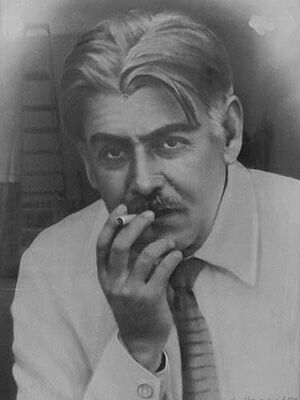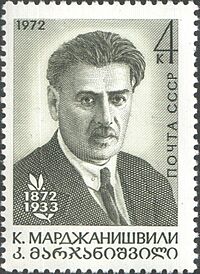Kote Marjanishvili facts for kids
Konstantine "Kote" Marjanishvili was a very important Georgian theater director. He was also known by his Russian name, Konstantin Aleksandrovich Mardzhanov. Born on May 28, 1872, he became famous for his amazing and often very large theater shows. He helped shape theater in Georgia, Russia, and the Soviet Union.
Early Life and Theater Work
Kote Marjanishvili grew up in a well-off family interested in books. His father was an army officer. He was born in Kvareli, a town in eastern Georgia. At that time, Georgia was part of the Russian Empire.
From 1893 to 1909, he worked as an actor and director in Georgia. Then, he moved to Russia. He changed his last name slightly to sound more Russian, becoming Mardzhanov.
He first worked in theaters in different Russian cities. By 1906, he joined the Nezlobin theater group in Moscow. He also helped start the Georgian Drama Studio. Kote Marjanishvili quickly became known as a talented follower of Konstantin Stanislavsky, a very famous Russian theater director. Marjanishvili helped actors find natural ways to show feelings on stage.
In 1910, Stanislavsky invited him to work at the Moscow Art Theatre. There, Marjanishvili directed plays by famous writers like Knut Hamsun and Henrik Ibsen. He also helped direct a play called Brothers Karamazov and another called Hamlet. He was very interested in how another director, Edward Gordon Craig, used puppet-like movements in his shows. Marjanishvili even went back to Georgia for a short time to direct Oedipus Rex in a similar style.
In 1913, he left Stanislavsky's theater to try new ideas. He started his own theater called the "Free Theater." This theater put on many different types of shows, including opera, plays, and pantomime. Famous artists like composer Sergei Rachmaninoff and singer Feodor Chaliapin worked with him. The theater also featured Georgian-style dances. However, it closed after about a year because of money problems. After that, he directed a local theater in Rostov-on-Don from 1914 to 1915.
After the Revolution
In 1917, Marjanishvili directed a play called Salomé by Oscar Wilde. It was a big success! This play continued to be shown during the big changes of the Russian Revolution. It was performed in cities like Kiev, Moscow, Petrograd (now St. Petersburg), and Tiflis (now Tbilisi).
He also worked on films from 1916 to 1928. In 1920, he helped direct a huge public show called Toward a Worldwide Commune.
In 1922, Marjanishvili returned to Georgia, which had recently joined the Soviet Union. He became the head of the Rustaveli Theater in Tbilisi. Another energetic young director, Sandro Akhmeteli, also returned to Tbilisi. He led younger actors who wanted new ideas. Marjanishvili and Akhmeteli worked together, even though they had different styles. Marjanishvili believed that theater should not show too much suffering. He felt there was "enough suffering in life without showing it on the stage."
In 1926, Marjanishvili and some of the actors left the Rustaveli Theater. They started a new traveling theater based in Kutaisi and Batumi. This new theater became known as The Second State Georgian Theater. In 1933, it was named the Marjanishvili Theater in his honor. This theater is still open in Tbilisi today. It continues Marjanishvili’s style of putting on many different kinds of shows.
In his later years, Marjanishvili worked in Moscow. He directed plays at the Korsh Theater, the Maly Theater, and the Operetta Theater in 1933. His new plays in Moscow often followed the ideas of the Soviet government. He won awards for his work in 1930. Kote Marjanishvili died of illness in Moscow on April 17, 1933.
Films Directed
- Before the Hurricane, 1924
- Krazana, 1926
- Amok, 1927



